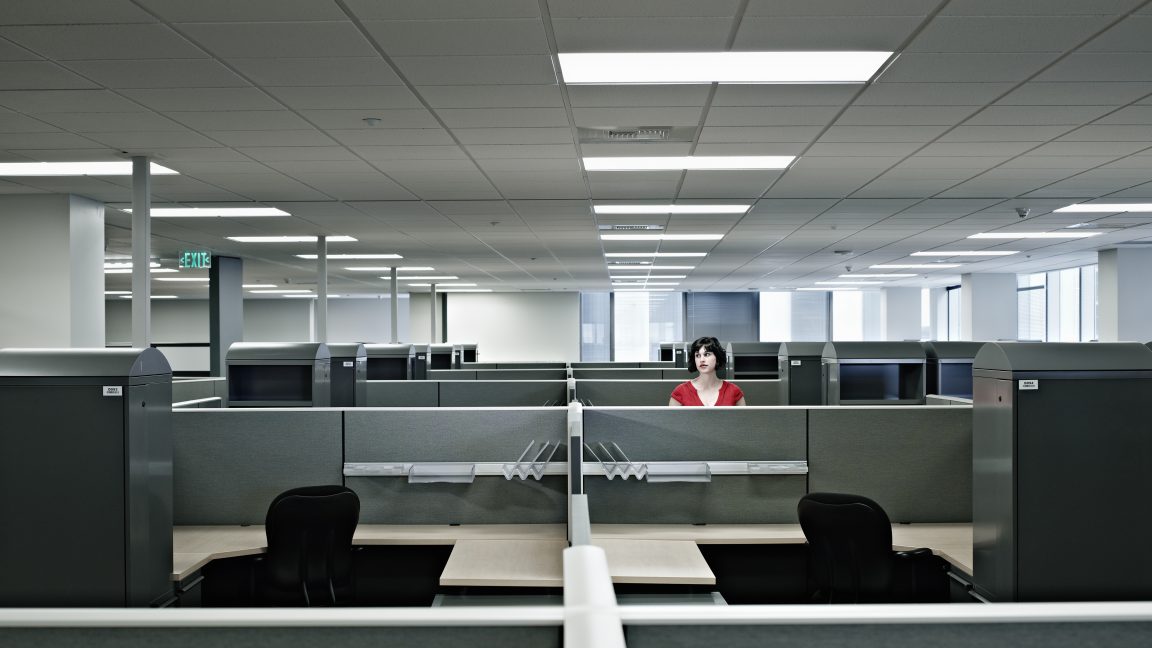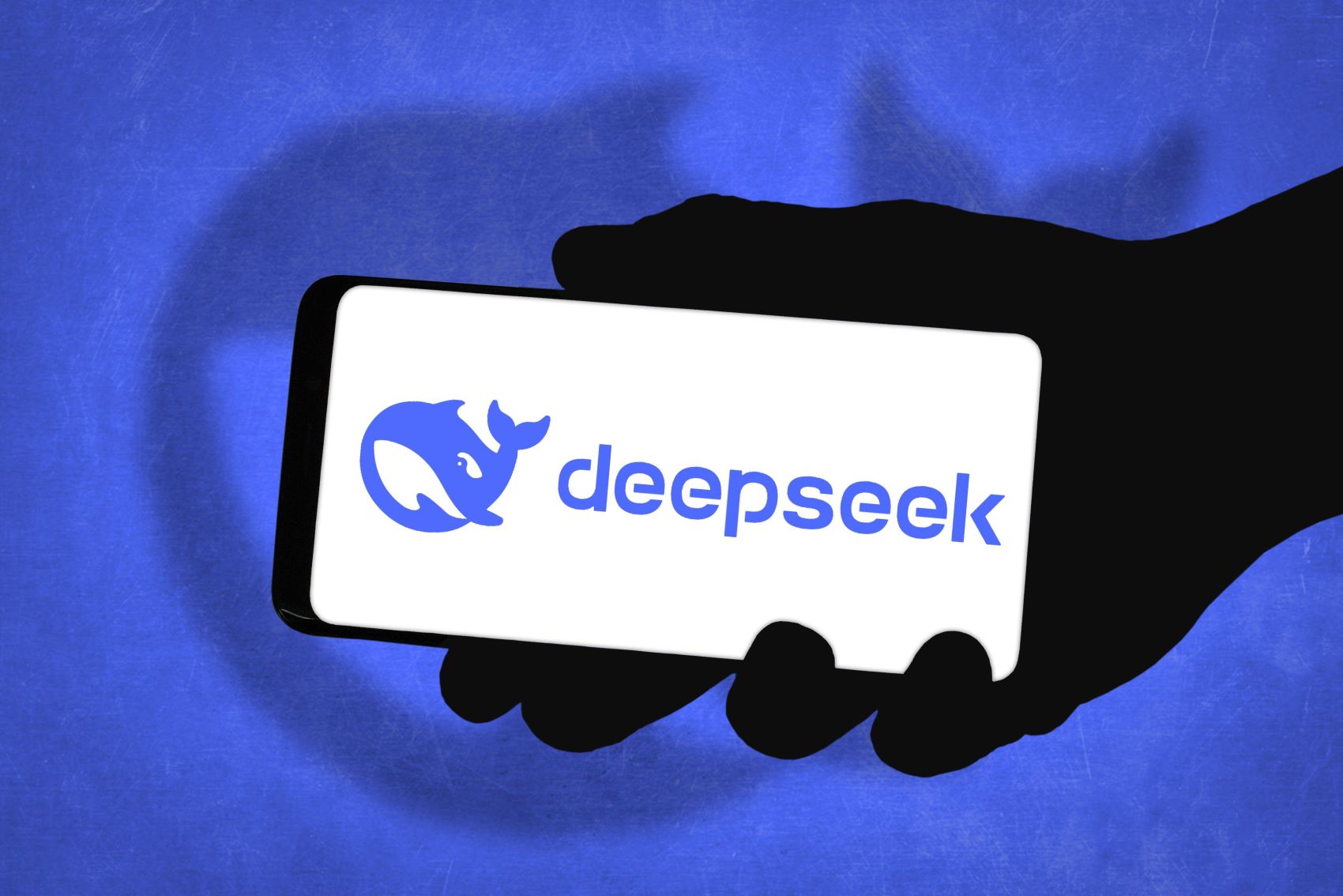
The surveillance tech waiting for workers as they return to the office
arstechnica.com
Big brother The surveillance tech waiting for workers as they return to the office Warehouse-style employee-tracking technology is coming for the office worker. Sophie Charara, wired.com Feb 27, 2025 9:15 am | 29 Credit: Thomas Barwick via Getty Credit: Thomas Barwick via Getty Story textSizeSmallStandardLargeWidth *StandardWideLinksStandardOrange* Subscribers only Learn moreScan the online brochures of companies who sell workplace monitoring tech and youd think the average American worker was a renegade poised to take their employer down at the next opportunity. Nearly half of US employees admit to time theft! Biometric readers for enhanced accuracy! Offer staff benefits in a controlled way with Vending Machine Access!A new wave of return-to-office mandates has arrived since the New Year, including at JP Morgan Chase, leading advertising agency WPP, and Amazonnot to mention President Trumps late January directive to the heads of federal agencies to terminate remote work arrangements and require employees to return to work in-person on a full-time basis. Five years on from the pandemic, when the world showed how effectively many roles could be performed remotely or flexibly, whats caused the sudden change of heart?Theres two things happening, says global industry analyst Josh Bersin, who is based in California. The economy is actually slowing down, so companies are hiring less. So there is a trend toward productivity in general, and then AI has forced virtually every company to reallocate resources toward AI projects.The expectation amongst CEOs is thats going to eliminate a lot of jobs. A lot of these back-to-work mandates are due to frustration that both of those initiatives are hard to measure or hard to do when we dont know what people are doing at home.The question is, what exactly are we returning to?Take any consumer tech buzzword of the 21st century and chances are its already being widely used across the US to monitor time, attendance, and, in some cases, the productivity of workers, in sectors such as manufacturing, retail, and fast food chains: RFID badges, GPS time clock apps, NFC apps, QR code clocking-in, Apple Watch badges, and palm, face, eye, voice, and finger scanners. Biometric scanners have long been sold to companies as a way to avoid hourly workers buddy punching for each other at the start and end of shiftsso-called time theft. A return-to-office mandate and its enforcement opens the door for similar scenarios for salaried staff.Track and traceThe latest, deluxe end point of these time and attendance tchotchkes and apps is something like Austin-headquartered HIDs OmniKey platform. Designed for factories, hospitals, universities, and offices, this is essentially an all-encompassing RFID log-in and security system for employees, via smart cards, smartphone wallets, and wearables. These will not only monitor turnstile entrances, exits, and floor access by way of elevators but also parking, the use of meeting rooms, the cafeteria, printers, lockers, and yes, vending machine access.These technologies, and more sophisticated worker location- and behavior-tracking systems, are expanding from blue-collar jobs to pink-collar industries and even white-collar office settings. Depending on the survey, approximately 70 to 80 percent of large US employers now use some form of employee monitoring, and the likes of PwC have explicitly told workers that managers will be tracking their location to enforce a three-day office week policy.Several of these earlier technologies, like RFID sensors and low-tech barcode scanners, have been used in manufacturing, in warehouses, or in other settings for some time, says Wolfie Christl, a researcher of workplace surveillance for Cracked Labs, a nonprofit based in Vienna, Austria. Were moving toward the use of all kinds of sensor data, and this kind of technology is certainly now moving into the offices. However, I think for many of these, its questionable whether they really make sense there.Whats new, at least to the recent pandemic age of hybrid working, is the extent to which workers can now be tracked inside office buildings. Cracked Labs published a frankly terrifying 25-page case study report in November 2024 showing how systems of wireless networking, motion sensors, and Bluetooth beacons, whether intentionally or as a byproduct of their capabilities, can provide behavioral monitoring and profiling in office settings.The project breaks the tech down into two categories: The first is technology that tracks desk presence and room occupancy, and the second monitors the indoor location, movement, and behavior of the people working inside the building.To start with desk and room occupancy, Spacewell offers a mix of motion sensors installed under desks, in ceilings, and at doorways in office spaces and heat sensors and low-resolution visual sensors to show which desks and rooms are being used. Both real-time and trend data are available to managers via its live data floorplan, and the sensors also capture temperature, environmental, light intensity, and humidity data.The Swiss-headquartered Locatee, meanwhile, uses existing badge and device data via Wi-Fi and LAN to continuously monitor clocking in and clocking out, time spent by workers at desks and on specific floors, and the number of hours and days spent by employees at the office per week. While the software displays aggregate rather than individual personal employee data to company executives, the Cracked Labs report points out that Locatee offers a segmented team analytics report that reveals data on small groups.As more companies return to the office, the interest in this idea of optimized working spaces is growing fast. According to S&S Insiders early 2025 analysis, the connected office was worth $43 billion in 2023 and will grow to $122.5 billion by 2032. Alongside this, IndustryARC predicts there will be a $4.5 billion employee-monitoring-technology market, mostly in North America, by 2026the only issue being that the crossover between the two is blurry at best.At the end of January, Logitech showed off its millimeter-wave radar Spot sensors, which are designed to allow employers to monitor whether rooms are being used and which rooms in the building are used the most. A Logitech rep told The Verge that the peel-and-stick devices, which also monitor VOCs, temperature, and humidity, could theoretically estimate the general placement of people in a meeting room. Logitech's Spot sensors can understand which rooms are in use, but also monitor things like temperature, CO2, and humidity. Credit: Logitech Logitech's Spot sensors can understand which rooms are in use, but also monitor things like temperature, CO2, and humidity. Credit: Logitech As Christl explains, because of the functionality that these types of sensor-based systems offer, there is the very real possibility of a creep from legitimate applications, such as managing energy use, worker health and safety, and ensuring sufficient office resources into more intrusive purposes.For me, the main issue is that if companies use highly sensitive data like tracking the location of employees devices and smartphones indoors or even use motion detectors indoors, he says, then there must be totally reliable safeguards that this data is not being used for any other purposes.Big brother is watchingThis warning becomes even more pressing where workers indoor location, movement, and behavior are concerned. Ciscos Spaces cloud platform has digitized 11 billion square feet of enterprise locations, producing 24.7 trillion location data points. The Spaces system is used by more than 8,800 businesses worldwide and is deployed by the likes of InterContinental Hotels Group, WeWork, the NHS Foundation, and San Jose State University, according to Ciscos website.While it has applications for retailers, restaurants, hotels, and event venues, many of its features are designed to function in office environments, including meeting room management and occupancy monitoring. Spaces is designed as a comprehensive, all-seeing eye into how employees (and customers and visitors, depending on the setting) and their connected devices, equipment, or assets move through physical spaces.Cisco has achieved this by using its existing wireless infrastructure and combining data from Wi-Fi access points with Bluetooth tracking. Spaces offers employers both real-time views and historical data dashboards. The use cases? Everything from meeting-room scheduling and optimizing cleaning schedules to more invasive dashboards on employees entry and exit times, the duration of staff workdays, visit durations by floor, and other behavior metrics. This includes those related to performance, a feature pitched at manufacturing sites.Some of these analytics use aggregate data, but Cracked Labs details how Spaces goes beyond this into personal data, with device usernames and identifiers that make it possible to single out individuals. While the ability to protect privacy by using MAC randomization is there, Cisco emphasizes that this makes indoor movement analytics unreliable and other applications impossibleleaving companies to make that decision themselves. Cisco Spaces is designed as an all-seeing eye to understand how employees (and customers or visitors, depending on the setting) move around a physical space. Credit: Cisco Cisco Spaces is designed as an all-seeing eye to understand how employees (and customers or visitors, depending on the setting) move around a physical space. Credit: Cisco Management even has the ability to send employees nudge-style alerts based on their location in the building. An IBM application, based on Ciscos underlying technology, offers to spot anomalies in occupancy patterns and send notifications to workers or their managers based on what it finds. Ciscos Spaces can also incorporate video footage from Cisco security cameras and WebEx video conferencing hardware into the overall system of indoor movement monitoring; another example of function creep from security to employee tracking in the workplace.Cisco is simply everywhere. As soon as employers start to repurpose data that is being collected from networking or IT infrastructure, this quickly becomes very dangerous, from my perspective, says Christl. With this kind of indoor location tracking technology based on its Wi-Fi networks, I think that a vendor as major as Cisco has a responsibility to ensure it doesnt suggest or market solutions that are really irresponsible to employers.I would consider any productivity and performance tracking very problematic when based on this kind of intrusive behavioral data. WIRED approached Cisco for comment but didnt receive a response before publication.Cisco isn't alone in this, though. Similar to Spaces, Junipers Mist offers an indoor tracking system that uses both Wi-Fi networks and Bluetooth beacons to locate people, connected devices, and Bluetooth tagged badges on a real-time map, with the option of up to 13 months of historical data on worker behavior.Junipers offering, for workplaces including offices, hospitals, manufacturing sites, and retailers, is so precise that it is able to provide records of employees device names, together with the exact enter and exit times and duration of visits between zones in officesincluding one labeled break area/kitchen in a demo. Yikes.For each of these systems, a range of different applications is functionally possible, and some raise labor-law concerns. A worst-case scenario would be that management wants to fire someone and then starts looking into historical records trying to find some misconduct, says Christl. "If its necessary to investigate employees, then there should be a procedure where, for example, a worker representative is looking into the fine-grained behavioral data together with management. This would be another safeguard to prevent misuse.Above and beyond?If warehouse-style tracking has the potential for management overkill in office settings, it makes even less sense in service and health care jobs, and American unions are now pushing for more access to data and quotas used in disciplinary action. Elizabeth Anderson, professor of public philosophy at the University of Michigan and the author of Private Government: How Employers Rule Our Lives, describes how black-box algorithm-driven management and monitoring affects not just the day-to-day of nursing staff but also their sense of work and value.Surveillance and this idea of time theft, its all connected to this idea of wasting time, she explains. Essentially all relational work is considered inefficient. In a memory care unit, for example, the system will say how long to give a patient breakfast, how many minutes to get them dressed, and so forth.Maybe an Alzheimers patient is frightened, so a nurse has to spend some time calming them down, or perhaps they have lost some ability overnight. Thats not one of the discrete physical tasks that can be measured. Most of the job is helping that person cope with declining faculties; it takes time for that, for people to read your emotions and respond appropriately. What you get is massive moral injury with this notion of efficiency.This kind of monitoring extends to service workers, including servers in restaurants and cleaning staff, according to a 2023 Cracked Labs report into retail and hospitality. Software developed by Oracle is used to, among other applications, rate and rank servers based on speed, sales, timekeeping around breaks, and how many tips they receive. Similar Oracle software that monitors mobile workers such as housekeepers and cleaners in hotels uses a timer for app-based micromanagementfor instance, you have two minutes for this room, and there are four tasks.As Christl explains, this simply doesnt work in practice. People have to struggle to combine what they really do with this kind of rigid, digital system. And its not easy to standardize work like talking to patients and other kinds of affective work, like how friendly you are as a waiter. This is a major problem. These systems cannot represent the work that is being done accurately.But can knowledge work done in offices ever be effectively measured and assessed either? In an episode of his podcast in January, host Ezra Klein battled his own feelings about having many of his best creative ideas at a caf down the street from where he lives rather than in The New York Times Manhattan offices. Anderson agrees that creativity often has to find its own path.Say theres a webcam tracking your eyes to make sure youre looking at the screen, she says. We know that daydreaming a little can actually help people come up with creative ideas. Just letting your mind wander is incredibly useful for productivity overall, but that requires some time looking around or out the window. The software connected to your camera is saying youre off-dutythat youre wasting time. Nobodys mind can keep concentrated for the whole work day, but you dont even want that from a productivity point of view.Even for roles where it might make more methodological sense to track discrete physical tasks, there can be negative consequences of nonstop monitoring. Anderson points to a scene in Erik Gandinis 2023 documentary After Work that shows an Amazon delivery driver who is monitored, via camera, for their driving, delivery quotas, and even getting dinged for using Spotify in the van.Its very tightly regulated and super, super intrusive, and its all based on distrust as the starting point, she says. What these tech bros dont understand is that if you install surveillance technology, which is all about distrusting the workers, there is a deep feature of human psychology that is reciprocity. If you dont trust me, Im not going to trust you. You think an employee who doesnt trust the boss is going to be working with the same enthusiasm? I dont think so.Trust issuesThe fixes, then, might be in the leadership itself, not more data dashboards. Our research shows that excessive monitoring in the workplace can damage trust, have a negative impact on morale, and cause stress and anxiety, says Hayfa Mohdzaini, senior policy and practice adviser for technology at the CIPD, the UKs professional body for HR, learning, and development. Employers might achieve better productivity by investing in line manager training and ensuring employees feel supported with reasonable expectations around office attendance and manageable workloads.A 2023 Pew Research study found that 56 percent of US workers were opposed to the use of AI to keep track of when employees were at their desks, and 61 percent were against tracking employees movements while they work.This dropped to just 51 percent of workers who were opposed to recording work done on company computers, through the use of a kind of corporate spyware often accepted by staff in the private sector. As Josh Bersin puts it, Yes, the company can read your emails with platforms such as Teramind, even including sentiment analysis of employee messages.Snooping on files, emails, and digital chats takes on new significance when it comes to government workers, though. New reporting from WIRED, based on conversations with employees at 13 federal agencies, reveals the extent of Elon Musks DOGE teams surveillance: software including Googles Gemini AI chatbot, a Dynatrace extension, and security tool Splunk have been added to government computers in recent weeks, and some people have felt they cant speak freely on recorded and transcribed Microsoft Teams calls. Various agencies already use Everfox software and Dtexs Intercept system, which generates individual risk scores for workers based on websites and files accessed.Alongside mass layoffs and furloughs over the past four weeks, the so-called Department of Government Efficiency has also, according to CBS News and NPR reports, gone into multiple agencies in February with the theater and bombast of full X-ray security screenings replacing entry badges at Washington, DC, headquarters. Thats alongside managers telling staff that their logging in and out of devices, swiping in and out of workspaces, and all of their digital work chats will be closely monitored going forward.Maybe theyre trying to make a big deal out of it to scare people right now, says Bersin. The federal government is using back-to-work as an excuse to lay off a bunch of people.DOGE staff have reportedly even added keylogger software to government computers to track everything employees type, with staff concerned that anyone using keywords related to progressive thinking or "disloyalty to Trump could be targetednot to mention the security risks it introduces for those working on sensitive projects. As one worker told NPR, it feels Soviet-style and Orwellian with nonstop monitoring. Anderson describes the overall DOGE playbook as a series of deeply intrusive invasions of privacy.Alternate realitiesBut what protections are out there for employees? Certain states, such as New York and Illinois, do offer strong privacy protections against, for example, unnecessary biometric tracking in the private sector, and Californias Consumer Privacy Act covers workers as well as consumers. Overall, though, the lack of federal-level labor law in this area makes the US something of an alternate reality to what is legal in the UK and Europe.The Electronic Communications Privacy Act in the US allows employee monitoring for legitimate business reasons and with the workers consent. In Europe, Algorithm Watch has made country analyses for workplace surveillance in the UK, Italy, Sweden, and Poland. To take one high-profile example of the stark difference: In early 2024, Serco was ordered by the UK's privacy watchdog, the Information Commissioners Office (ICO), to stop using face recognition and fingerprint scanning systems, designed by Shopworks, to track the time and attendance of 2,000 staff across 38 leisure centers around the country. This new guidance led to more companies reviewing or cutting the technology altogether, including Virgin Active, which pulled similar biometric employee monitoring systems from 30-plus sites.Despite a lack of comprehensive privacy rights in the US, though, worker protest, union organizing, and media coverage can provide a firewall against some office surveillance schemes. Unions such as the Service Employees International Union are pushing for laws to protect workers from black-box algorithms dictating the pace of output.In December, Boeing scrapped a pilot of employee monitoring at offices in Missouri and Washington, which was based on a system of infrared motion sensors and VuSensor cameras installed in ceilings, made by Ohio-based Avuity. The U-turn came after a Boeing employee leaked an internal PowerPoint presentation on the occupancy- and headcount-tracking technology to The Seattle Times. In a matter of weeks, Boeing confirmed that managers would remove all the sensors that had been installed to date.Under-desk sensors, in particular, have received high-profile backlash, perhaps because they are such an obvious piece of surveillance hardware rather than simply software designed to record work done on company machines. In the fall of 2022, students at Northeastern University hacked and removed under-desk sensors produced by EnOcean, offering presence detection and people counting, that had been installed in the schools Interdisciplinary Science & Engineering Complex. The university provost eventually informed students that the department had planned to use the sensors with the Spaceti platform to optimize desk usage.OccupEye (now owned by FM: Systems), another type of under-desk heat and motion sensor, received a similar reaction from staff at Barclays Bank and The Telegraph newspaper in London, with employees protesting and, in some cases, physically removing the devices that tracked the time they spent away from their desks. Sapience offers various software packages to deliver workplace data to employers, including return-to-office compliance. Credit: Sapience Sapience offers various software packages to deliver workplace data to employers, including return-to-office compliance. Credit: Sapience Despite the fallout, Barclays later faced a $1.1 billion fine from the ICO when it was found to have deployed Sapiences employee-monitoring software in its offices, with the ability to single out and track individual employees. Perhaps unsurprisingly in the current climate, that same software company now offers lightweight device-level technology to monitor return-to-office policy compliance, with a dashboard breaking employee location down by office versus remote for specific departments and teams.According to Elizabeth Andersons latest book Hijacked, while workplace surveillance culture and the obsession with measuring employee efficiency might feel relatively new, it can actually be traced back to the invention of the work ethic by the Puritans in the 16th and 17th centuries.They thought you should be working super hard; you shouldnt be idling around when you should be in work, she says. You can see some elements there that can be developed into a pretty hostile stance toward workers. The Puritans were obsessed with not wasting time. It was about gaining assurance of salvation through your behavior. With the Industrial Revolution, the no wasting time became a profit-maximizing strategy. Now youre at work 24/7 because they can get you on email.Some key components of the original work ethic, though, have been skewed or lost over time. The Puritans also had strict constraints on what duties employers had toward their workers: paying a living wage and providing safe and healthy working conditions.You couldnt just rule them tyrannically, or so they said. You had to treat them as your fellow Christians, with dignity and respect. In many ways the original work ethic was an ethic which uplifted workers.This story originally appeared on wired.com.Sophie Charara, wired.com Wired.com is your essential daily guide to what's next, delivering the most original and complete take you'll find anywhere on innovation's impact on technology, science, business and culture. 29 Comments
0 Kommentare
·0 Anteile
·51 Ansichten








